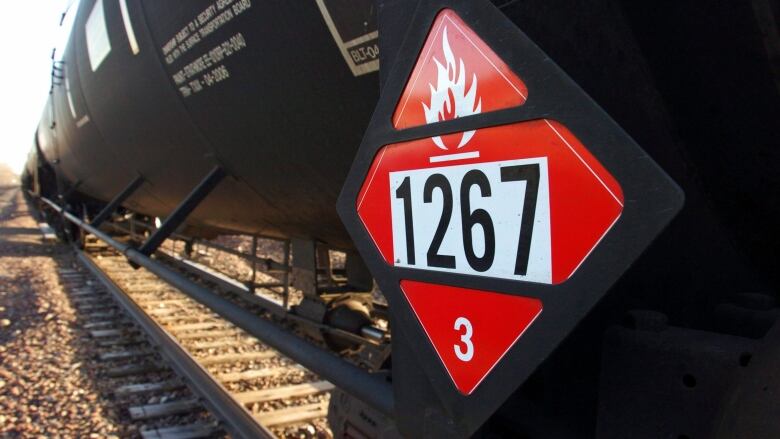Oil-by-rail shipments set to boom, study finds
Growth of petroleum-related shipments will outpace overall railway use, say energy researchers

Shipments of petroleum-related products by rail could nearly triple in Western Canada and double in Eastern Canada over the next eight years.
That's the conclusion of the Canadian Energy Research Initiative, which has analyzed what commodities railways are carrying across Canada in a new report.
CETI sees petroleum-related rail traffic in Western Canada, by which it means provinces fromManitoba west, rising from 204,581 cars a year in 2012 to 790,597 railcars in 2024.
In Eastern Canada, the region from Ontario east, oil-by-rail would climb from 199,787 railcars in 2012 to 384,429 in 2024.
Overall rail traffic is expected to grow by 44 per cent by 2024 in Western Canada and 39 per cent in Eastern Canada, with petroleum products making up a growing share of the mix.
"Our conclusion is that the rail system is going to grow over the next 10 years and is growing in part by other products and in part by crude, but it's not going to grow to the extent that it can't accommodate it," Peter Howard, CETI president emeritus and author of the report, said in an interview with CBC News.
He dismissed the idea that crude would displace other products from the rail lines, though he said there might be a need for double tracking between Winnipeg and Calgary or Edmonton.
Safety concerns
There has been intense scrutiny of petroleum shipments by rail since the accident in Lac-Mgantic that claimed the lives of 47 people.
The federal government proposed a standard for stronger rail cars earlier this year after a series of rail accidents in which rail cars carrying petroleum products leaked or caught fire.
The prospect of a big boost in shipment of oil by rail is bound to cause concern, as many of Canada's largest cities are along major rail routes.
Howard said CETI studied rail commodity shipments in part to assess the implications for the petroleum sector, as crude-by-rail options will be necessary unless there is new pipeline capacity.
One of the options for petroleum producers is to ship a form of bitumen called neatbit, rather than dilbit, which is shipped now. New heavier-duty rail cars can handle neatbit, which is heavier that dilbitas it is 95 per cent bitumen.
"One of the offsets of using the rail system is the new changes in cars, rather than putting dilbit into those cars a fuel that can actually crash and burn, the next wave of crude is called neatbit," Howard said.
"What that means on go-forward basis, if there are any accidents, if they punctured the side of the tank, it would spill out on the ground, which could be cleaned up."
Coal and wheat
Coal currently is the most commonly moved commodity across Canada, accounting for nearly a quarter of rail traffic in some parts of the country, but that number is likely to fall as coal falls out of use because of climate concerns.
Wheat is another big user, but petroleum and petroleum products come in at number three, accounting for 405,368 railcars across Canada every year in 2012, the base year of the study.
Petroleum-related shipments account for eight per cent of the tonnage in Western Canada and nine per cent of the tonnage transported in Eastern Canada. Tonnage is different from number of rail cars as commodities have different weights.
And because CN Rail networks extend both down to the U.S. and north to Fort McMurray, Alta., they provide a conduit for petroleum products to the Gulf Coast. Petroleum shipments for export will grow at more than 33 per cent a year until at least 2018, CETI said.












_(720p).jpg)


 OFFICIAL HD MUSIC VIDEO.jpg)
.jpg)



























































































